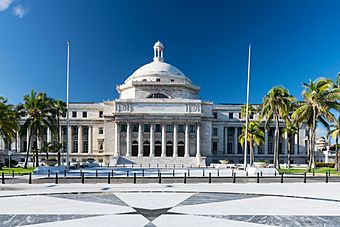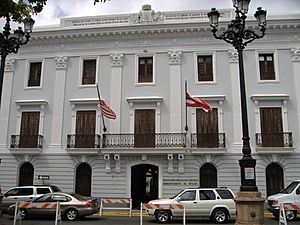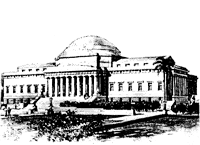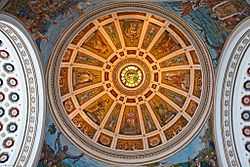Capitol of Puerto Rico facts for kids
Quick facts for kids |
|
|
El Capitolio de Puerto Rico
|
|

Front view of the Puerto Rico Capitol
|
|
| Location | Avenida Ponce de León and Avenida Muñoz Rivera, San Juan, Puerto Rico |
|---|---|
| Built | 1929 |
| Architect | Rafael Carmoega |
| Architectural style | Classical Revival, Beaux Arts |
| NRHP reference No. | 77001555 |
| Added to NRHP | November 18, 1977 |
The Capitol of Puerto Rico (Spanish: Capitolio de Puerto Rico) is a very important building in San Juan. It's where the laws of Puerto Rico are made! This beautiful building is home to the Legislative Assembly. This assembly has two main parts: the House of Representatives and the Senate.
The Capitol is located on the Islet of San Juan, just outside the old walls of Old San Juan. People sometimes call it the Palace of the Laws (Spanish: Palacio de las Leyes).
Contents
Building the Capitol
Before the Capitol was built, the lawmakers met in another building. This building now houses the Department of State.
The idea for a new Capitol building came from Luis Muñoz Rivera in 1907. He was a Resident Commissioner for Puerto Rico. Building a Capitol would show that Puerto Rico had its own government. At that time, Puerto Rico was a colony of the United States.
Luis Muñoz Rivera suggested spending $3 million on the building. He also wanted a contest for architects to design it.
Choosing a Design
In September 1907, an official request for architects was sent out. It went to newspapers and magazines in the United States. The new building needed to have space for three main groups: the Executive Council, the House of Delegates, and the Supreme Court. The design had to be simple and fit the island's weather.
Many architects sent their ideas. There were 134 designs from the US, Cuba, Canada, France, Spain, and Puerto Rico. A special group looked at all the designs. This group included important people like William F. Willoughby and José de Diego.
Three American architects were also part of the group. In the end, three projects were chosen. They were from Frank E. Perkins, James H. Ritchie and Lewis B. Abbot, and Henry L. Beadle.
The project chosen was by Frank E. Perkins. His design was in a neoclassical style. It had a central courtyard and a dome. The dome looked a bit like the Pantheon in Rome.
However, many people in Puerto Rico liked a different design. This design was by a Puerto Rican engineer named Carlos del Valle Zeno. His project had a Renaissance style. But his design was not chosen because he had put a slogan on his plans, which was against the rules.
Construction Begins
Even though people liked Del Valle's design, Perkins was hired. But the project was put on hold. In 1920, the project started again. The Department of Interior found Perkins's design not quite right. New plans were made in the Renaissance style.
Construction of the Capitol began in 1921. But it stopped after the first floor was finished. Later, Rafael Carmoega took over the project. He worked with other architects to create a new design.
Their design used some ideas from Perkins's original plan, including the dome. The dome was inspired by the Low Memorial Library at Columbia University.
The Capitol building was officially opened on February 11, 1929. The first meeting of the Legislative Assembly happened there just three days later. In 1977, the Capitol was added to the U.S. National Register of Historic Places.
Capitol Building Complex
The Capitol is not just one building. It's a group of buildings! These buildings were designed in the 1950s.
- The Rafael Martínez Nadal building is like an "annex" for the Senate. It has offices for senators and meeting rooms.
- The Ernesto Ramos Antonini building is the House Annex. It has offices for representatives and more meeting rooms.
- The Luis Muñoz Marín Office Building holds the Office of Legislative Services.
- The Luis A. Ferré Building has offices for both parts of the Legislative Assembly. It also has a large parking garage.
- The Antonio R. Barceló Building has offices for both chambers and the Legislative Library.
- The Ramón Mellado Parsons Building has more Senate offices.
These buildings help the government of Puerto Rico work smoothly.
Images for kids
See also
 In Spanish: Capitolio de Puerto Rico para niños
In Spanish: Capitolio de Puerto Rico para niños









